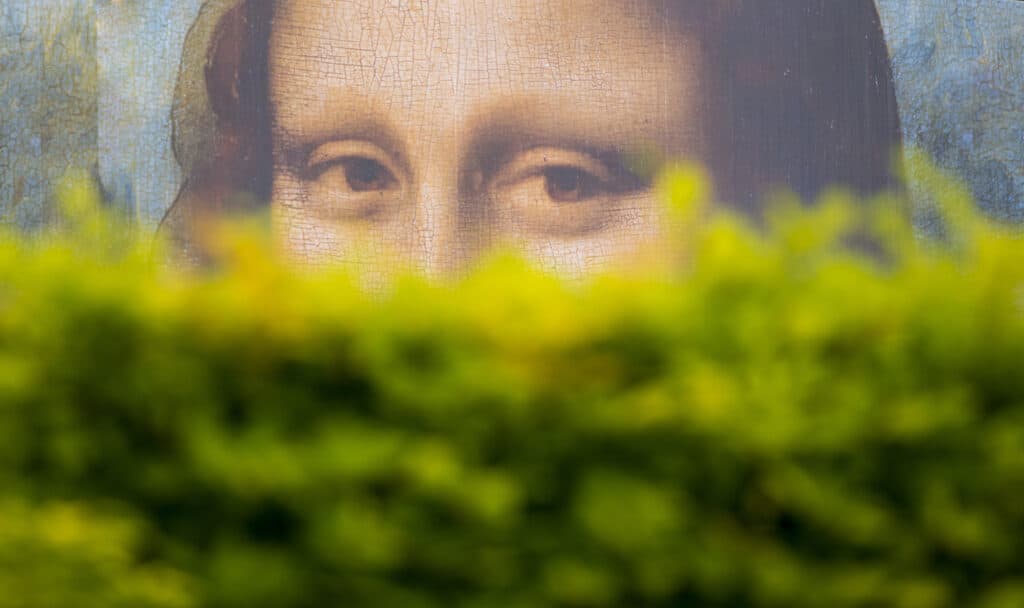Painted by Leonardo da Vinci, the “Mona Lisa” is considered the most famous portrait in the world. Who has owned the painting through its history and who owns it today?
The “Mona Lisa” is owned by the nation of France, having previously been in the possession of the French royal family. Leonardo da Vinci had moved to France before he died and it was acquired by King Francis I. Today, it is situated in the Louvre in Paris.

For more on the history of the “Mona Lisa” and how it came to be the world’s most famous portrait, read on.
Creation
Despite being one of the most famous paintings in history, very little is known about the actual creation of the painting with certainty. It was created by Leonardo da Vinci at some point in the early 1500s but the identity of the woman in the painting, as well as who commissioned it and how it ended up in France, are all hotly debated subjects.
Scholars believe that the painting was commissioned by Francesco del Giocondo, a cloth merchant living in Florence. The sitter is believed to be Giocondo’s wife, Lisa Gherardini, and the painting’s alternate name La Gioconda supports this theory.
It is also theorized that the painting was commissioned to mark one of two occasions. The first of these was the birth of the couple’s second son, Andrea, in 1502 after losing a daughter in 1499.
The fact that the woman in the painting is wearing what is sometimes considered a mourning veil supports this theory. Her enigmatic smile birthed the term “Gioconda smile”, used to refer to an expression similar to the painting.
Another possible reason for the commissioning of the portrait was the purchase of a house by Giocondo and his wife in 1503. Both of these theories are consistent with the timeframe of the painting’s creation.
Significance
In addition to its artistic beauty, the “Mona Lisa” is also representative of a shift in the composition of portraits. It is the earliest example of an Italian portrait that focuses closely on a single sitter in half-length and includes the subject’s arms and hands within the frame.
Inspired by Flemish painting conventions of the 1400s but with a different composition, the “Mona Lisa” influenced countless pieces of artwork in the centuries since its creation. It also marked a shift in Leonardo’s work, as it was the first of his portraits to be composed in such a manner.
Ownership
For unknown reasons, the painting did not enter the ownership of the man who commissioned it, believed to be Giocondo. It is believed that Leonardo kept the painting in his possession for more than a decade, continuing to make slight adjustments to it throughout this time.
Leonardo moved to France in 1516 and likely took the painting with him to continue working on it, which would explain how it came to be in the country. He would have had to cease working on the painting in 1517 at the latest as he lost the use of his right hand, explaining why it was not entirely finished.
At some point, the painting entered the ownership of the French royal family and was varnished at some point in the 1500s. After the French Revolution deposed the abolition of the traditional monarchy, the “Mona Lisa” was placed in the Louvre in Paris.
It has remained in the Louvre ever since, with some exceptions. Napoleon had it placed in his bedroom in the Tuileries Palace in the early 1800s.
The painting had only been known to the art world for much of its history but began gaining wider fame in the 1860s. It was temporarily relocated to the arsenal in Brest during the Franco-Prussian War of 1870 to 1871.
The “Mona Lisa” was stolen on August 21, 1911, eventually found to have been taken by Vincenzo Peruggia, a Louvre employee. Peruggia was Italian and believed the painting belonged in Leonard’s home in Italy.
He kept the painting in his apartment for two years but was caught when trying to sell it, subsequently sent to prison for six months. It was moved again during World War II but eventually put back in the Louvre, where it has remained since.
Like the gallery it has been placed in, the Mona Lisa is the property of the nation of France. In 1962, it was valued at $100 million for insurance, making it the most valuable painting in history.